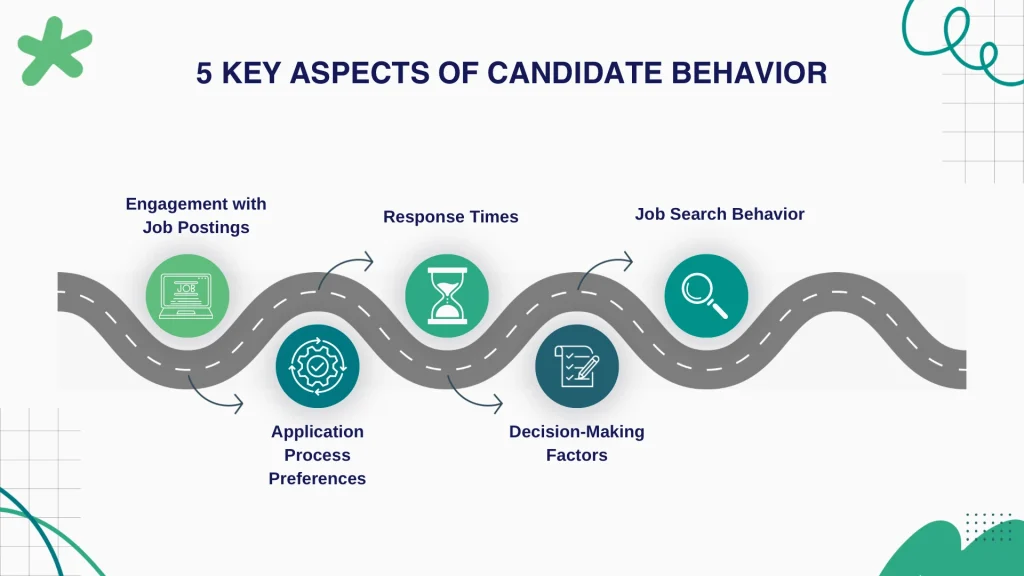In today’s competitive job market, organizations increasingly use mass hiring strategies to meet their staffing needs. However, the success of these initiatives hinges not only on attracting a large pool of candidates but also on understanding and effectively responding to candidate behavior.
By delving into the patterns and preferences of job seekers, companies can refine their recruitment processes, enhance candidate experience, and ultimately secure top talent more efficiently.
A LinkedIn report found that 86% of job seekers research a company’s reputation before applying. This means candidate behavior isn’t just about how applicants respond to job postings, it’s about how they engage with the company’s profile and hiring process.
By understanding these behaviors, companies can optimize their mass recruitment strategies, improve candidate experience, and attract top talent more effectively.

Defining Candidate Behavior
Before moving forward, it is important to understand candidates’ behavior, it is about how job seekers act and make decisions throughout the hiring process respond to your communications, and ultimately decide whether to accept or reject a job offer.
Key Aspects of Candidate Behavior during Hiring Process:
Understanding candidate behavior is crucial for making informed hiring decisions. This section highlights five key aspects that influence how candidates engage with potential employers and navigate the hiring process, they are:
1. Engagement with Job Postings
This means that candidates not only read job descriptions but also research your company’s reputation. How you present the job ad (clear, concise, and engaging) and your employer brand can significantly impact whether candidates even consider applying.
2. Application Process Preferences
The way candidates approach the application process is another critical behavior. Many job seekers prefer quick, straightforward applications.
3. Response Times
Understanding this behavior means recruiters need to act quickly, speeding up interview scheduling, follow-ups, and feedback to maintain candidate engagement.
4. Decision-Making Factors
Understanding these preferences allows you to craft job offers that resonate with the right candidates, increasing the chances they’ll accept.
5. Job Search Behavior
This highlights the importance of employer branding and how your job ads are distributed. Candidates may research companies on LinkedIn, review online employee feedback, or even check out social media before deciding to apply.
Understanding candidates behaviors during hiring process will allows recruiters to tailor their strategies to meet candidates’ expectations and preferences.
Why Understanding Candidate Behavior is Important in Mass Hiring
After defining how candidates behave during job searches and applications, hope it can help companies to improve in hiring successfully. Why does this matter? Here is why:
1. It Keeps Candidates Engaged
Today’s job seekers expect a hiring process that is smooth, fast, and personalized. If companies fail to engage with them effectively, they risk losing potential hires.
For example, a study found that 60% of candidates (Gen Z) abandon applications is the process too rigid and time-consuming (Onrec). This means long, complicated applications or slow response times can drive top talent away.
By tracking candidate behavior, such as:
- how they interact with job postings
- how quickly they respond to messages,
- whether they open follow-up emails,
By understanding these, the recruiters can adjust their approach. Automated but personalized communication, clear job descriptions, and faster interview scheduling can help keep candidates engaged and motivated to complete the process.
2. It Reduces Candidate Drop-Off Rates
One of the biggest challenges in mass hiring is that candidates start an application but don’t finish it.
This can happen for several reasons:
- the application is too long,
- the process is unclear, or
- there’s little follow-up from recruiters.
Understanding when and why candidates drop off allows companies to make necessary changes. If analytics show that most candidates leave at the assessment stage, for example, it might mean the test is too lengthy or irrelevant.
Simplifying applications, making expectations clear, and providing timely updates can significantly improve completion rates.
3. It Speeds Up the Hiring Process
Recruiting at scale often leads to bottlenecks, too many applications to review, slow interview scheduling, or delayed responses to candidates. This not only frustrates job seekers but also causes businesses to lose good candidates to faster-moving competitors.
According to Linkedin, companies that utilize AI-driven candidate behavior analysis fill positions 40% faster than those that rely on traditional hiring methods.
When recruiters understand how quickly candidates expect to move through the process, they can prioritize applications, automate routine tasks, and respond faster ensuring they don’t lose top talent due to delays.
4. It Increases Offer Acceptance Rates
Getting an offer in front of a candidate doesn’t guarantee they’ll accept it. Many job seekers weigh multiple offers before making a decision, and their choices are often influenced by mobility, salary, career growth opportunities, and company culture.
If recruiters understand what matters most to candidates, they can craft more appealing job offers. For example, if data shows that candidates in a certain industry prioritize remote work, offering flexible options can make the role more attractive.
By aligning job offers with candidate expectations, companies improve their chances of securing top talent.
By paying attention to how job seekers engage with the hiring process, companies can create a candidate-focused approach that leads to a stronger workforce and a better employer reputation.
Strategies to Leverage Candidate Behavior in Mass Hiring
Understanding candidate behavior is only the first step, what truly makes a difference is applying this knowledge to enhance your mass hiring strategy.
By using insights into how candidates act and what influences their decisions, companies can make smarter, more data-driven decisions that improve the efficiency and success of their hiring process. Here are some key strategies to leverage candidate behavior in mass hiring:
Tips 1: Personalize the Candidate Experience
Today’s candidates expect a personalized experience. According to YourCX, 75% of job seekers are more likely to apply if they feel the job description and recruitment process are tailored to their needs and experiences. This can be done by:
- Tailoring Job Descriptions: Make sure job postings are clear, concise, and reflect the culture of your company. Highlight key benefits, growth opportunities, and what makes your company stand out.
- Personalized Communication: Use automated but personalized messages to keep candidates engaged. For example, acknowledging their application, providing interview updates, and giving them feedback can enhance the candidate’s experience and keep them interested.
Tips 2: Simplify the Application Process
One of the most common reasons candidates abandon applications is a complex or lengthy process. As mentioned before, 60% of candidates abandon applications because the forms are too long or complicated. To address this:
- Simplify the Application Form: Make it as easy and fast as possible to apply. Consider allowing candidates to upload resumes or use LinkedIn profiles to autofill application forms.
- Mobile Optimization: Many candidates apply using their smartphones, so ensure your application system is mobile-friendly to capture those on-the-go job seekers.
Tips 3: Implement Behavioral Assessments
Behavioral assessments are tools that help you evaluate a candidate’s personality, skills, and motivations. These assessments provide deeper insights into how a candidate will perform in the role and how well they will fit within the company culture. According to TalentLyft, companies that use pre-employment assessments see a 39% increase in employee retention.
Behavioral assessments help predict long-term success by measuring traits like:
- Problem-solving skills
- Cultural fit
- Emotional intelligence
By integrating these assessments into the recruitment process, you can ensure you are hiring candidates who will thrive in the role and stay longer with your organization.
Tips 4: Use Data Analytics for Smarter Decision-Making
The more data you have, the better decisions you can make. Leverage analytics to understand patterns in candidate behavior, such as application drop-offs, preferred communication times, and engagement levels. This allows recruiters to make data-driven decisions that improve both candidate experience and hiring efficiency.
For examples:
- Analyze Drop-Off Points: If candidates tend to abandon the application process at a particular stage (like the skills assessment), consider revising that part of the process.
- Predict Candidate Interest: By tracking which candidates engage the most with job postings and communications, you can prioritize your outreach to the most promising applicants.
Using data analytics to understand and respond to candidate behavior leads to faster decision-making and better-quality hires.
Tips 5: Strengthen Employer Branding
Candidates today not only want a job, they want to work for a company they believe in. As mentioned before, 86% of job seekers research a company’s reputation before applying. This means your employer brand matters more than ever.
To enhance your employer brand:
- Showcase Company Culture: Use social media, job postings, and your website to give candidates a real sense of your company’s values and culture. Share stories of employees, highlight community involvement, and make sure your brand messaging is consistent across all channels.
- Improve Candidate Communication: Keep candidates informed about where they stand in the hiring process. A simple message like “Thank you for applying” or “We’re reviewing your application” can go a long way in building a positive perception.
A strong employer brand not only attracts top talent but also makes candidates more likely to apply and accept job offers.
Tips 6: Speed Up the Hiring Process
Candidates are more likely to accept offers when they know they won’t have to wait forever for a decision. 66% of candidates expect to hear back less than two week of applying (CareerBuilder). To speed up your hiring process:
- Set Clear Timelines: Communicate a clear timeline for the hiring process and stick to it. Let candidates know when they can expect to hear back and ensure that interviews and feedback are delivered on time.
- Use Automation Tools: Automating some aspects of your hiring process (such as interview scheduling, sending offer letters, etc.) can save time and reduce administrative burden on recruiters.
By understanding candidate behavior and implementing the strategies above, it is expected that companies can maximize their existing mass hiring processes.
Challenges in Mass Hiring and How to Overcome Them
In executing mass hiring, there are certainly challenges that companies face. Below are the common challenges and how to overcome them:
Issue 1: High Volume of Applicants
Mass hiring often results in a large number of applicants, which can overwhelm recruiters and lead to delays in the screening and interview process.
How to Overcome:
- Use Applicant Tracking Systems (ATS): Implementing an ATS can help streamline the sorting and screening process by automatically filtering candidates based on specific criteria (e.g., skills, experience).
- Automate Initial Assessments: Use online assessments to narrow down the candidate pool early on, allowing recruiters to focus on the most qualified individuals.
Issue 2: Maintaining Consistent Candidate Experience
With a high number of applicants, it can be challenging to maintain a consistent and positive candidate experience. Slow responses, lack of communication, or a disorganized process can lead to frustration and candidate drop-off.
How to Overcome:
- Set Clear Expectations: Communicate timelines and keep candidates updated throughout the process. Even if there are delays, informing candidates about where they stand can help maintain interest.
- Personalize Communication: Even in mass hiring, personalized emails or messages can help candidates feel valued. Automated systems can be used to send personalized updates, making the process feel more engaging.
Issue 3: Ensuring a Cultural Fit
Hiring a large number of candidates quickly increases the risk of hiring individuals who may not align with the company’s culture, which can lead to higher turnover rates.
How to Overcome:
- Behavioral Assessments: Integrating behavioral assessments into the hiring process can help identify candidates who fit well with the company culture.
- Clear Job Descriptions: Make sure that job descriptions clearly outline the values, culture, and expectations of the company to attract candidates who align with those principles.
Issue 4: Recruitment Process Delays
Recruiters may face bottlenecks in the hiring process, such as waiting for interview schedules or delayed feedback, leading to candidates losing interest.
How to Overcome:
- Maximize the Interview Process: Streamline the interview process by scheduling interviews in bulk or conducting virtual interviews to save time.
- Automate Routine Tasks: Automate administrative tasks such as interview scheduling and feedback collection, allowing recruiters to focus on high-priority tasks.
Issue 5: Lack of Proper Technology and Tools
Without the right technology in place, handling large volumes of applications can become overwhelming, and manual processes can lead to inefficiencies.
How to Overcome:
- Invest in Modern Recruitment Technology: Use AI-driven tools and advanced analytics to track candidate behavior, streamline the hiring process, and improve decision-making.
- Use Video Interviewing Platforms: Video interviews can help speed up the process and allow recruiters to assess candidates remotely, saving time and resources.
Issue 6: Quality vs. Quantity
While mass hiring focuses on filling positions quickly, there is always the risk of prioritizing quantity over quality. Hiring too many candidates who aren’t the right fit can be costly in the long run.
How to Overcome:
- Refine Screening Criteria: Establish strong criteria based on the skills and experience needed for the role to ensure you’re attracting the right candidates.
- Focus on Talent Pool: Build a strong talent pool of pre-vetted candidates who can be called upon when mass hiring is necessary. This reduces the pressure of hiring quickly and ensures quality.
Mass hiring can be a powerful way to meet staffing demands quickly, but it does come with its challenges. By implementing strategies such as using technology, maintaining clear communication, and focusing on cultural fit, companies can overcome these obstacles and execute a more efficient, successful mass hiring process.
Conclusion
In conclusion, it can be concluded that candidates or job seekers are most attracted to during the hiring process are:
- Company Reputation and Employer Branding
- Clear and Engaging Job Descriptions
- Simple and Fast Application Process
- Responsive Communication and Fast Hiring Process
- Attractive Job Offers
- Personalized Candidate Experience
By focusing on these factors, companies can improve their mass hiring success and attract top talent more effectively.
By understanding candidate behavior and leveraging these insights into candidate preferences and actions, organizations can create more efficient, engaging, and successful recruitment processes. This approach not only attracts top talent but also fosters a positive employer brand, contributing to long-term organizational success.
Looking for help?
If you’re struggling with mass hiring, partnering with a recruitment agency can be a game-changer.
Gini Talent is a leading recruitment agency specializing in mass hiring. Their experts can help your company find the right talent while also strengthening your employer branding.
Scale your hiring with Gini Talent, and find top talent fast!




